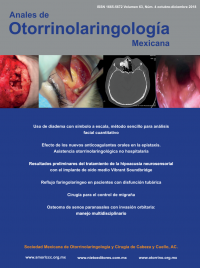Preliminary results of the treatment of sensorineural hearing loss with middle ear implant Vibrant Soundbridge.
An Orl Mex. 2018 octubre-diciembre;63(4):150-158.
Rosa Isela Banda-González,1 Francisco José Gallardo-Ollervides,2 Saúl Alejandro Moreno-Reynoso3
1 Médico adscrito al Gabinete de Audiología.
2 Jefe del Servicio.
3 Médico adscrito al Servicio.
Servicio de Otorrinolaringología y Cirugía de Cabeza y Cuello, Hospital Central Militar, Ciudad de México.
Resumen
ANTECEDENTES: El 20% de los usuarios de auxiliares auditivos no está satisfecho, por tal razón es de gran importancia considerar otras opciones de tratamiento.
OBJETIVO: Mostrar los resultados preliminares del tratamiento de la hipoacusia neurosensorial con el implante de oído medio Vibrant Soundbridge.
MATERIAL Y MÉTODO: Estudio observacional, descriptivo y transversal, efectuado del 1 de enero de 2017 a mayo de 2018, en el que se incluyeron pacientes con hipoacusia bilateral moderada-severa neurosensorial, con uso de auxiliar auditivo y que mostraban escasa discriminación a la voz, afección infecciosa recurrente del conducto auditivo externo o sensación de oclusión. Se realizaron los siguientes estudios de forma pre y posoperatoria: audiometría tonal, logoaudiometría, timpanometría, ganancia funcional tonal e índice de utilidad social.
RESULTADOS: Se incluyeron cinco pacientes. Hubo ganancia de 8.5 dB con el uso del implante Vibrant Soundbridge, al compararlo con el auxiliar auditivo convencional, e índice de utilidad social 11.7% mayor que con el uso de auxiliar auditivo.
CONCLUSIONES: Los implantes de oído medio son una alternativa de tratamiento para los pacientes con hipoacusia neurosensorial que no reciben beneficio con el uso de auxiliares auditivos convencionales o que por cuestiones médicas no pueden usarlos. Proporciona mejor ganancia tonal y mejor discriminación de palabras que los auxiliares auditivos convencionales.
PALABRAS CLAVE: Implante de oído medio; hipoacusia neurosensorial; auxiliar auditivo.
Abstract
BACKGROUND: The 20% of the hearing aid’s users are not complete satisfied, for this reason it is very important to consider other treatment options.
OBJECTIVE: To present preliminary results of the treatment of sensorineural hearing loss with the middle ear implant Vibrant Soundbridge.
MATERIAL AND METHOD: An observational, descriptive and cross-sectional study was done from January 1st 2017 to May 2018, with patients with bilateral moderate-severe sensorineural hearing loss, and despite of hearing aid presented poor discrimination to the voice, recurrent infectious pathology of external ear or occlusion sensation. The following studies were performed pre and postoperatively: audiometry logoaudiometry, tympanometry, functional gain and social utility index.
RESULTS: There were included five patients. Functional gain of 8.5 dB was obtained with the use of the implant Vibrant Soundbridge, when compared with the conventional hearing aid, as well as better social utility index (11.7%) than with the use of auditory aids.
CONCLUSIONS: Middle ear implants are an alternative treatment for patients with sensorineural hearing loss who do not benefit from the use of conventional hearing aids or who, due to medical reasons, can not use them. It provides better tonal gain and better word discrimination than conventional hearing aids.
KEYWORDS: Middle ear implant; Sensorineural hearing loss; Hearing aid.


